Abstract
Temozolomide (CCRG 81045: M&B 39831: NSC 362856) is an analogue of mitozolomide displaying similar broad spectrum activity in mouse tumours, but showing considerably less myelosuppression in the toxicology screen. Temozolomide was initially studied intravenously at doses between 50-200 mg m-2 and subsequently was given orally up to 1,200 mg m-2. A total of 51 patients were entered on the single dose schedule. Temozolomide exhibits linear pharmacokinetics with increasing dose. Myelotoxicity was dose limiting. Experimentally, temozolomide activity was schedule dependent and therefore oral administration was studied as a daily x 5 schedule between total doses of 750 and 1,200 mg m-2 in 42 patients. Myelosuppression was again dose limiting. The recommended dose for Phase II trials is 150 mg m-2 po for 5 days (total dose 750 mg m-2) for the first course, and if no major myelosuppression is detected on day 22 of the 4 week cycle, the subsequent courses can be given at 200 mg m-2 for 5 days (total dose 1 g m-2) on a 4 week cycle. Mild to moderate nausea and vomiting was dose related but readily controlled with antiemetics. Clinical activity was detected using the 5 day schedule in four (2CR, 2PR; 17%) out of 23 patients with melanoma and in one patient with mycosis fungoides (CR lasting 7 months). Two patients with recurrent high grade gliomas have also had partial responses. Temozolomide is easy to use clinically and generally well tolerated. In the extended Phase I trial temozolomide only occasionally exhibited the unpredictable myelosuppression seen with mitozolomide.
Full text
PDF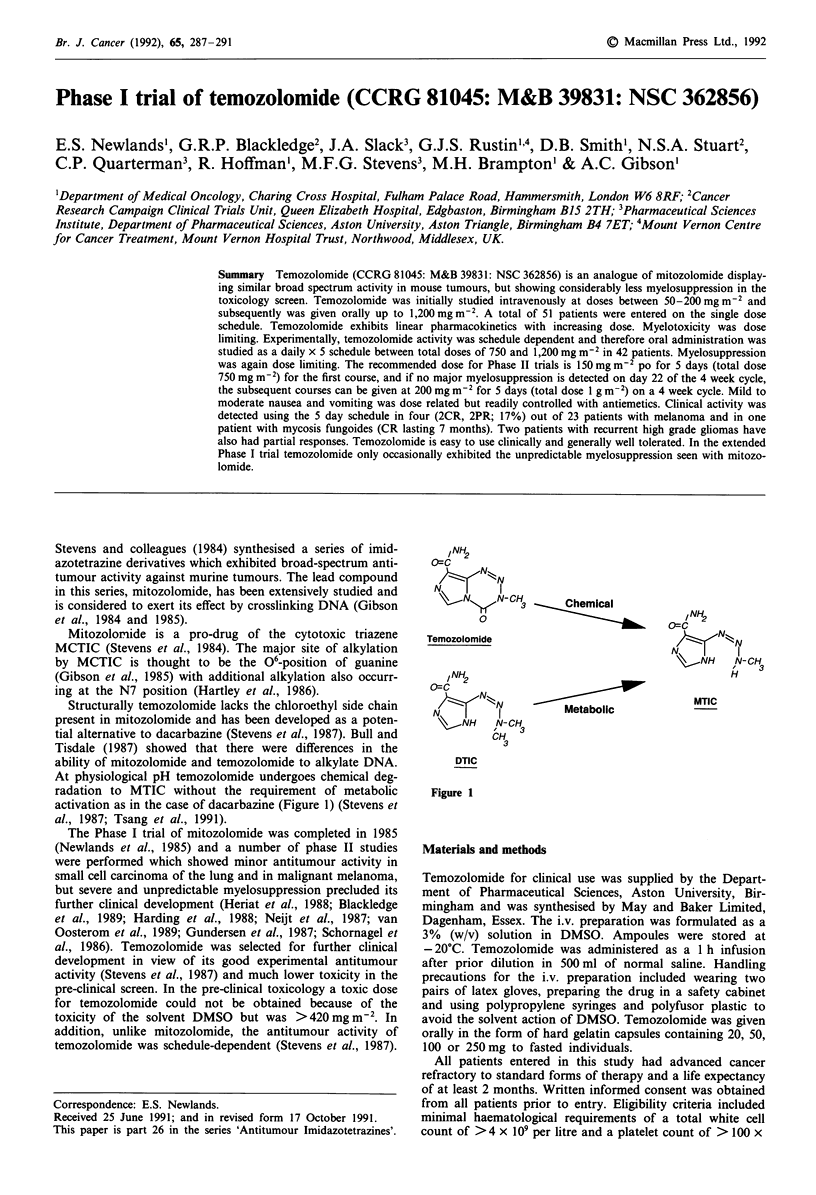
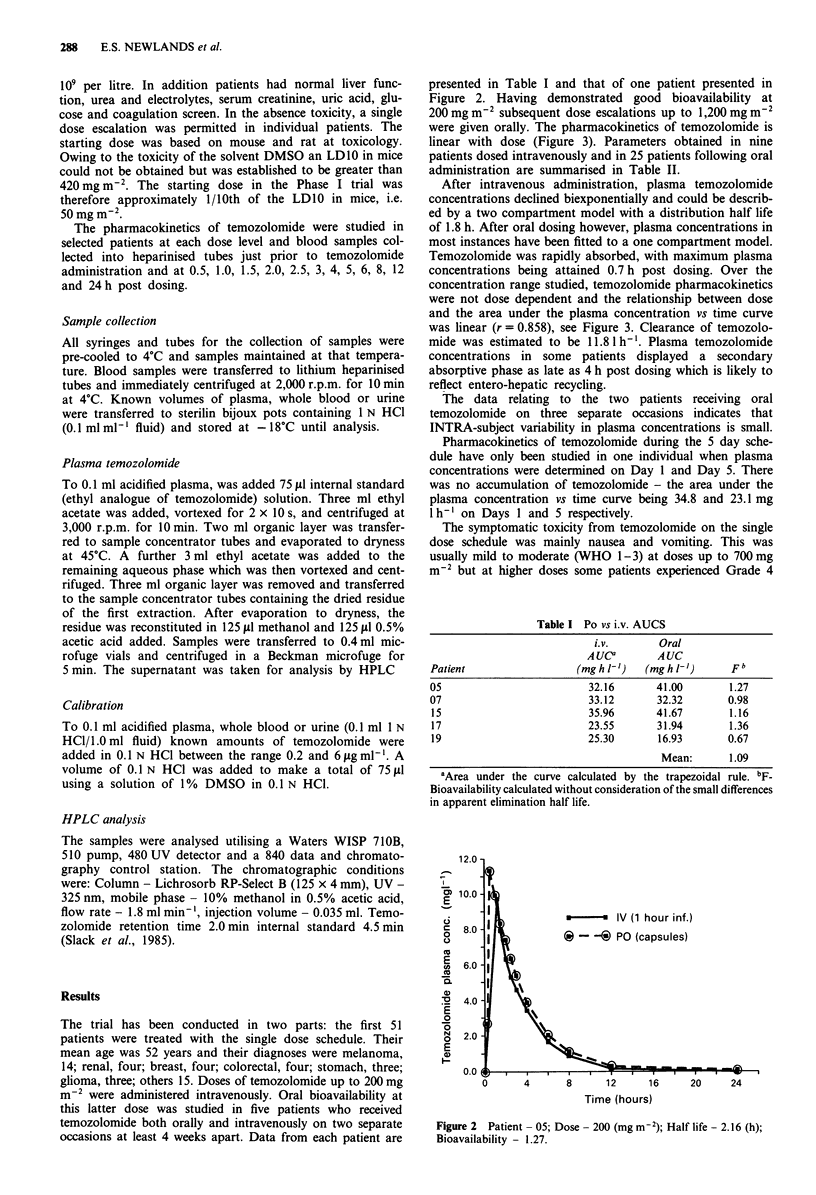
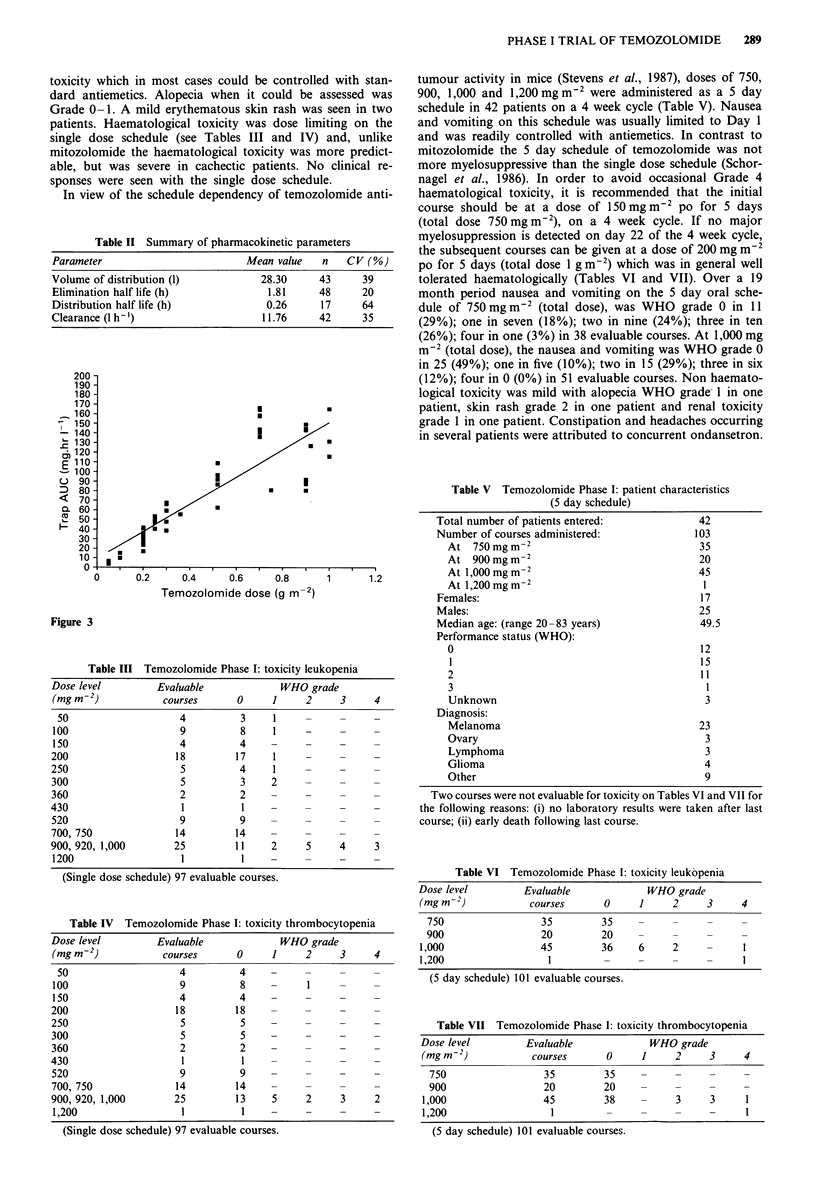
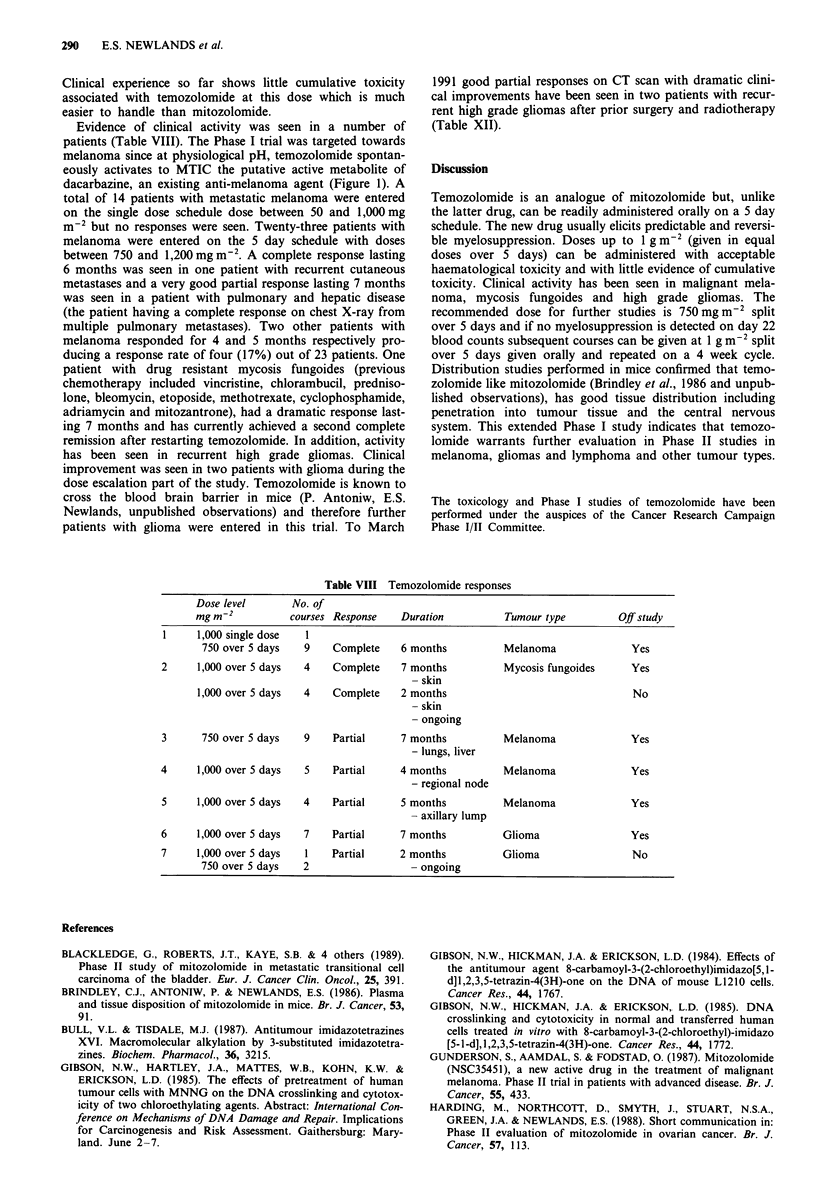
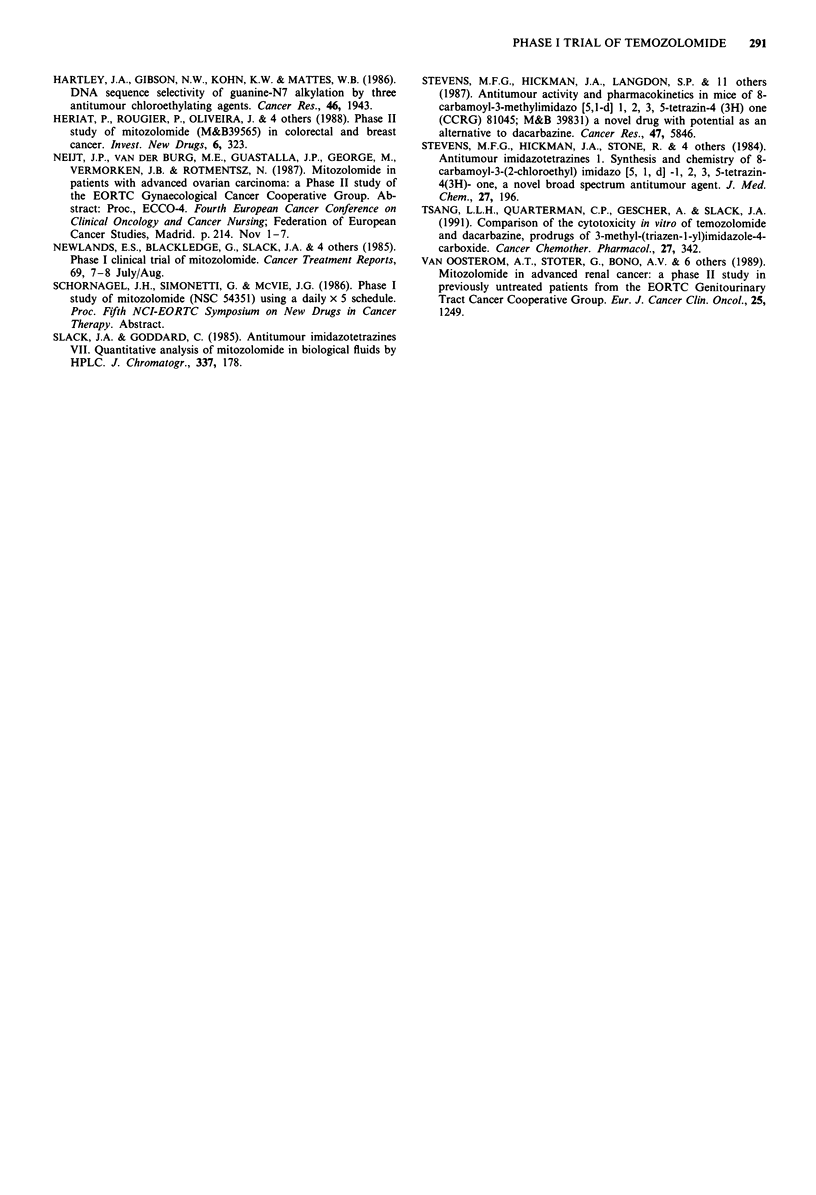
Selected References
These references are in PubMed. This may not be the complete list of references from this article.
- Blackledge G., Roberts J. T., Kaye S., Taylor R., Williams J., de Stavola B., Uscinska B. A phase II study of mitozolomide in metastatic transitional cell carcinoma of the bladder. Eur J Cancer Clin Oncol. 1989 Feb;25(2):391–392. doi: 10.1016/0277-5379(89)90036-9. [DOI] [PubMed] [Google Scholar]
- Brindley C. J., Antoniw P., Newlands E. S. Plasma and tissue disposition of mitozolomide in mice. Br J Cancer. 1986 Jan;53(1):91–97. doi: 10.1038/bjc.1986.13. [DOI] [PMC free article] [PubMed] [Google Scholar]
- Bull V. L., Tisdale M. J. Antitumour imidazotetrazines--XVI. Macromolecular alkylation by 3-substituted imidazotetrazinones. Biochem Pharmacol. 1987 Oct 1;36(19):3215–3220. doi: 10.1016/0006-2952(87)90636-8. [DOI] [PubMed] [Google Scholar]
- Gibson N. W., Erickson L. C., Hickman J. A. Effects of the antitumor agent 8-carbamoyl-3-(2-chloroethyl)imidazo[5,1-d]-1,2,3,5-tetrazin-4(3 H)-one on the DNA of mouse L1210 cells. Cancer Res. 1984 May;44(5):1767–1771. [PubMed] [Google Scholar]
- Gibson N. W., Hickman J. A., Erickson L. C. DNA cross-linking and cytotoxicity in normal and transformed human cells treated in vitro with 8-carbamoyl-3-(2-chloroethyl)imidazo[5,1-d] -1,2,3,5-tetrazin-4(3H)-one. Cancer Res. 1984 May;44(5):1772–1775. [PubMed] [Google Scholar]
- Gundersen S., Aamdal S., Fodstad O. Mitozolomide (NSC 353451), a new active drug in the treatment of malignant melanoma. Phase II trial in patients with advanced disease. Br J Cancer. 1987 Apr;55(4):433–435. doi: 10.1038/bjc.1987.85. [DOI] [PMC free article] [PubMed] [Google Scholar]
- Harding M., Northcott D., Smyth J., Stuart N. S., Green J. A., Newlands E. Phase II evaluation of mitozolomide in ovarian cancer. Br J Cancer. 1988 Jan;57(1):113–114. doi: 10.1038/bjc.1988.21. [DOI] [PMC free article] [PubMed] [Google Scholar]
- Hartley J. A., Gibson N. W., Kohn K. W., Mattes W. B. DNA sequence selectivity of guanine-N7 alkylation by three antitumor chloroethylating agents. Cancer Res. 1986 Apr;46(4 Pt 2):1943–1947. [PubMed] [Google Scholar]
- Herait P., Rougier P., Oliveira J., Delgado F. M., May-Levin F., Hayat M., Armand J. P. Phase II study of mitozolomide (M & B 39,565) in colorectal and breast cancer. Invest New Drugs. 1988 Dec;6(4):323–325. doi: 10.1007/BF00173652. [DOI] [PubMed] [Google Scholar]
- Slack J. A., Goddard C. Antitumour imidazotetrazines. VII. Quantitative analysis of mitozolomide in biological fluids by high-performance liquid chromatography. J Chromatogr. 1985 Jan 11;337(1):178–181. [PubMed] [Google Scholar]
- Stevens M. F., Hickman J. A., Langdon S. P., Chubb D., Vickers L., Stone R., Baig G., Goddard C., Gibson N. W., Slack J. A. Antitumor activity and pharmacokinetics in mice of 8-carbamoyl-3-methyl-imidazo[5,1-d]-1,2,3,5-tetrazin-4(3H)-one (CCRG 81045; M & B 39831), a novel drug with potential as an alternative to dacarbazine. Cancer Res. 1987 Nov 15;47(22):5846–5852. [PubMed] [Google Scholar]
- Stevens M. F., Hickman J. A., Stone R., Gibson N. W., Baig G. U., Lunt E., Newton C. G. Antitumor imidazotetrazines. 1. Synthesis and chemistry of 8-carbamoyl-3-(2-chloroethyl)imidazo[5,1-d]-1,2,3,5-tetrazin-4(3 H)-one , a novel broad-spectrum antitumor agent. J Med Chem. 1984 Feb;27(2):196–201. doi: 10.1021/jm00368a016. [DOI] [PubMed] [Google Scholar]
- Tsang L. L., Quarterman C. P., Gescher A., Slack J. A. Comparison of the cytotoxicity in vitro of temozolomide and dacarbazine, prodrugs of 3-methyl-(triazen-1-yl)imidazole-4-carboxamide. Cancer Chemother Pharmacol. 1991;27(5):342–346. doi: 10.1007/BF00688855. [DOI] [PubMed] [Google Scholar]
- van Oosterom A. T., Stoter G., Bono A. V., Splinter T. A., Fossa S. D., Verbaeys A. J., de Mulder P. H., de Pauw M., Sylvester R. Mitozolomide in advanced renal cancer. A phase II study in previously untreated patients from the EORTC Genito-Urinary Tract Cancer Cooperative Group. Eur J Cancer Clin Oncol. 1989 Aug;25(8):1249–1250. doi: 10.1016/0277-5379(89)90422-7. [DOI] [PubMed] [Google Scholar]


